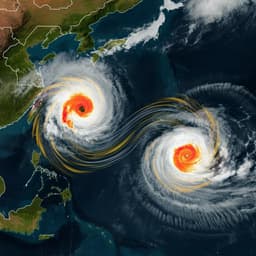
Earth Sciences
Predictability of South-Asian monsoon rainfall beyond the legacy of Tropical Ocean Global Atmosphere program (TOGA)
B. N. Goswami, D. Chakraborty, et al.
This groundbreaking research by B. N. Goswami, Deepayan Chakraborty, P. V. Rajesh, and Adway Mitra reveals how North Atlantic sea-surface temperature significantly influences Indian Summer Monsoon Rainfall, challenging previous understandings of ENSO's dominance. Discover the intricacies of weather patterns and their global connections!
~3 min • Beginner • English
Introduction
With the country's food production and economy depending on it, the Indian summer monsoon rainfall (ISMR) is the lifeline of one-fifth of the world's population living in the region. It is not surprising, therefore, that developing a model for forewarning of ISMR one season in advance has a history of more than a century in India led by the pioneering work of Blanford. Despite great advances in ocean-atmosphere observation, computing resources, development of improved empirical and coupled climate models for ISMR prediction, the prediction of ISMR remains a grand challenge problem in climate science. Although many different predictors have been identified for predicting ISMR since then, the El Nino and Southern Oscillation (ENSO) has remained the leading predictable driver of ISMR, even though the relationship between ISMR and an ENSO index shows a weakening trend in recent decades with a tendency for recovery to higher negative correlations in more recent years. With ISMR defined from another dataset, however, the ENSO-ISMR correlation continues to decrease in recent years. Further, the maximum negative correlation between ISMR and Nino3.4 SST takes place 3–4 months after the peak of ISMR, suggesting a potential role of ISMR in driving the ENSO. In fact the lead-lag relationship indicates that the ISMR could feedback and influence the ENSO making the ENSO-ISMR relationship tangled and potentially a bi-directional causality. It is also notable that the ENSO-ISMR relationship undergoes a multi-decadal variation implying that there are periods when ENSO could explain up to 35% of inter-annual variability of ISMR while there are periods when it could explain less than 10% of ISMR variability. Further, it is noted that a nearly equal number of floods and droughts occur without a La Nina or an El Nino, indicating the role of non-ENSO drivers on observed inter-annual variability of ISMR.
A recent study argues that the traditional signal-to-noise estimates of potential skill or limit of potential predictability are underestimated and a model-based estimate of potential skill indicates that it could be much higher than previously thought explaining up to 70% of inter-annual variability of ISMR, far beyond that could be explained by association with the ENSO. Some additional sources of ISMR predictability come from other slowly varying potential drivers like the Eurasian snow cover, Pacific Decadal Oscillation (PDO), Indian Ocean Dipole Mode, the Atlantic Nino and Atlantic tripole, have been explored recently. However, the physical mechanisms through which they influence the ISMR, the robustness of the relationships, and the fraction of ISMR variability explained by them are still being debated. As a result, the causality and the direction of causality between these potential drivers and ISMR are neither well established nor their independence from the ENSO and the North-Atlantic sea-surface temperature (SST) variability is established.
In addition to the ENSO, there is considerable evidence that cold NA SSTs are associated with mega-droughts of Indian monsoon in the past. In recent years, the NA SST is also linked with ISMR on multi-decadal time-scales. While the North-Atlantic multi-decadal variability (alternately also known as the Atlantic multi-decadal oscillation, AMO) could be modified by either natural or anthropogenic aerosols, ocean-atmosphere feedback is critical for the basic multi-decadal variability in the Atlantic. With considerable evidence of decadal predictability of the North-Atlantic climate and the AMO, it represents an extra-tropical predictable driver for ISMR. In addition, the Southern Annular Mode (SAM) also has a notable association with the ISMR variability. While the SAM is a manifestation of internal atmospheric dynamics with typical auto-correlation of ~2 weeks, it also has a forced or coupled component with modest seasonal predictability due to its significant association and linkage with the ENSO. Therefore, the SAM is unlikely to contribute to ISMR predictability over and above that arises from association between ENSO and ISMR.
The primary objective of this article is to establish beyond reasonable doubt that the NA-SST or the AMO is an independent driver of the ISMR variability. For establishing the same, first, we need a physical mechanism connecting the NA SST and ISMR. A framework for such a physical teleconnection mechanism has emerged from several recent studies. According to it, positive (negative) NA SST drives a large-scale anticyclonic (cyclonic) barotropic vorticity over it on intraseasonal time-scales and sets up an upper level zonal-wave number four Rossby wave-train that produce significant upper level anticyclonic (cyclonic) vorticity over the Indian region that in turn strengthen (weaken) low-level cyclonic vorticity associated with the Indian monsoon. Long active (break) spells as a result of clustering of the spells lead to strengthening (weakening) of the seasonal mean ISMR. The Rossby wave-train represents a North-Atlantic-Indian (NAI) teleconnection pattern for linking extra-tropical NA SST to tropical ISMR.
In the present study, we start by describing the NAI pattern of teleconnection between NA SST and ISMR. However, a missing element of the puzzle of teleconnection between the AMO and the ISMR is, how the NA extra-tropical SST drive the local barotropic vorticity on intraseasonal time-scales. The conventional wisdom indicates that unlike in the tropics, the atmosphere drives SST anomalies in the extra-tropics. While that may be true on synoptic time-scales, here we provide evidence that indeed the NA SST could drive barotropic vorticity above it on intraseasonal time-scales bridging the missing link in the teleconnection between the AMO and the ISMR. The last important remaining issue is that the causality has not been quantified rigorously. Although the functional relationship between the driver time series like the AMO and the ISMR is intrinsically nonlinear, the causal inference algorithms used so far are all based on linear correlations and regressions and do not adequately address the independence of AMO-ISMR relationship from that with other potential drivers. To test the robustness of our conclusions, we quantify the causality between the AMO and the ISMR in the presence of a number of other potential drivers using two different advanced nonlinear causal inference algorithms and unravel that the NA SST is indeed a driver of the ISMR through a simultaneous atmospheric bridge independent of the ENSO and its impact on the ISMR is comparable to that of the ENSO. We further show that it achieves the same through the NA SST driving a intraseasonal barotropic vorticity above it, which in turn drives extended intraseasonal spells of rainfall over the Indian monsoon region that leads to seasonal mean ISMR anomalies.
Literature Review
Prior work has long identified ENSO as the leading predictor of ISMR, though its relationship with ISMR has weakened and varies on multi-decadal timescales. Studies propose additional predictors and mechanisms including Eurasian snow cover, PDO, Indian Ocean Dipole (IOD), Atlantic Niño, and Atlantic tripole, but their mechanisms, robustness, and independence from ENSO and NA SST remain debated. There is paleo and observational evidence linking cold North Atlantic SSTs to Indian monsoon megadroughts and multi-decadal ISMR variability via the Atlantic Multidecadal Oscillation (AMO). Theoretical and modeling studies have established extra-tropical to tropical teleconnections via Rossby wave trains (e.g., PNA from ENSO forcing). A hypothesized NAI teleconnection posits NA SST anomalies driving barotropic vorticity and a zonal wave-4 Rossby wave-train influencing the Indian monsoon. Prior causal analyses have been largely linear and bivariate, insufficient to disentangle confounding among multiple drivers (ENSO, AMO, PDO, NAO, IOD, Atlantic Niño).
Methodology
Data and indices: ISMR is represented by the Parthasarathy station-based monthly rainfall dataset (1871–2016). AMO is defined as box-averaged SST anomalies over 0°–60°N, 75°W–5°W (North Atlantic). NAO is defined from standardized sea level pressure differences between boxes 37.5°–42.5°N, 32.5°–27.5°W and 62.5°–67.5°N, 22.5°–17.5°W. ENSO (Nino3.4) is SST at 5°S–5°N, 170°W–120°W. PDO is the leading PC of North Pacific SST variability north of 20°N. Atlantic Niño is SST over 20°W–0°E, 3°S–3°N. IOD is the SST difference between 10°N–10°S, 50°E–70°E and 10°S–0°, 90°E–110°E.
Primary SST fields: COBE SST2 (1850–2016) for monthly indices; for weekly/daily analyses, NOAA OISST v2 and ECMWF ERA5 daily SST were used. Atmospheric fields (SLP, winds, precipitation, geopotential height, vorticity) are from NCEP 20CRv3; ERA5 daily vorticity used for intraseasonal analyses. All weekly datasets were averaged and interpolated to 1°×1°.
Derived variables and regions: Barotropic vorticity (BV) is defined as the 700–200 hPa layer-mean vorticity over 60°W–0°E, 30°–65°N (North Atlantic). Indian upper-level vorticity (IUV, 200 hPa) and lower-level vorticity (ILV, 850 hPa) are area means over 60°–90°E, 10°–35°N. Central India rainfall (CI-ISMR) area is 72°–86°E, 14°–28°N. A summer NAO index for JJAS is defined by JJAS MSLP box differences between (40°W–30°W, 40°–30°N) and (30°W–20°W, 50°–60°N).
Timescales and preprocessing: For contemporaneous seasonal teleconnections (atmospheric bridge), monthly mean anomalies during MJJASO for 1871–2017 were analyzed with a maximum lag of 5 months, ensuring lags within the same boreal summer. All monthly indices were detrended. Intraseasonal analyses used JJAS daily data (1980/1982–2017), smoothed with a 7-day moving average to isolate intraseasonal variability. Weekly SST–BV lead–lag correlations (SST leads/lags up to ±3 weeks) were computed to assess driver–response timing.
Causal discovery: Two frameworks were applied. (1) PCMCI+ (from the Tigramite package) with conditional independence tests to infer contemporaneous and lagged causal graphs under assumptions of causal sufficiency and the Markov condition. Seasonal multivariate network nodes: ISMR, AMO (NA SST), Nino3.4 (ENSO), NAO, PDO, IOD, Atlantic Niño; significance α=0.05 (95% CI). Intraseasonal PCMCI+ network nodes: NA-SST, NAO, BV, IUV, ILV, CI-ISMR; significance α=0.01 (99% CI). (2) Granger causality (both linear using ridge regression and nonlinear using Random Forest with 100 trees), on the same MJJASO monthly anomalies (1871–2017), to test robustness of PCMCI+ results; significance at 95%.
Mode decomposition: To extract multi-decadal modes (MDMs), ICEEMDAN (CEEMDAN) was employed on fields over 1850–2015, with the AMO MDM identified as IMF-5. Regressions of AMO MDM onto SST, 200 hPa geopotential height, and winds were used to diagnose the NAI wave-train. Model analyses: CMIP6 simulations (e.g., MPI_ESM1-2_HR) were used to assess simulated ISMR–NA SST teleconnections and causality patterns.
Hypothesis testing: The proposed mechanism posits that NA SST modulates NAO, which drives BV anomalies; BV forces an upper-level Rossby wave-train producing IUV anomalies over India, modulating intraseasonal active/break spell clustering and thereby seasonal mean ISMR. This pathway was tested via intraseasonal PCMCI+ and lead–lag statistics.
Key Findings
- North Atlantic SST/AMO is an independent driver of ISMR variability, with causal influence comparable in magnitude to ENSO, acting via an atmospheric bridge with ~1-month lead.
- A North-Atlantic–Indian (NAI) teleconnection pattern exists: NA SST anomalies drive a zonal wave-4 Rossby wave-train that induces upper-level anticyclonic/cyclonic vorticity over India, modulating deep convection and intraseasonal spell clustering, thereby affecting seasonal ISMR.
- Weekly lead–lag correlations show SST leads barotropic vorticity (BV) over NA by 1–2 weeks, with predominantly negative correlations (warm SST overlain by anticyclonic BV), indicating SST drives BV on intraseasonal time scales.
- Intraseasonal PCMCI+ (JJAS daily, 1980s–2017) supports the pathway: NA-SST positively drives NAO, which drives BV (Pcorr ≈ −0.489); BV drives IUV positively; IUV drives CI-ISMR negatively (Pcorr ≈ −0.2). Net effect: NA-SST positively drives CI-ISMR (Pcorr ≈ 0.316).
- Seasonal PCMCI+ (MJJASO monthly, 1871–2017) shows: ENSO negatively drives ISMR; AMO positively drives ISMR; ENSO–ISMR link is bidirectional; AMO–ISMR is one-way (AMO→ISMR). PDO has no direct link to ISMR; NAO’s relation to ISMR is mediated by AMO; Atlantic Niño is directionlessly linked with AMO and lacks a direct ISMR link; IOD–ISMR link is weak/ambiguous and dataset-dependent.
- Granger causality corroborates: Nonlinear Granger detects AMO→ISMR at 1–2 month leads and Nino→ISMR at 1-month lead (both 95% CI), aligning in sign with PCMCI+. Linear Granger detects AMO→ISMR at 1-month lead.
- Under ENSO-neutral summers (JJAS Nino3.4 within ±0.25 s.d.), NA-SST correlates with ISMR at r ≈ 0.47 (significant), implying NA-SST can explain ~20% of ISMR variance; ENSO explains a similar fraction based on lag-0 correlations.
- CMIP6 analyses (e.g., MPI_ESM1-2_HR) reproduce multi-decadal ISMR–NA SST links and NAI-like wave-trains; several models simulate AMO→ISMR causality, though biases remain (e.g., ENSO–ISMR correlation weaker than observed, teleconnection shifts).
Discussion
Findings demonstrate that extra-tropical North Atlantic SST variability (AMO) causally modulates the Indian summer monsoon via a fast atmospheric bridge and an NAI Rossby wave-train, independent of ENSO. This mechanism operates by SST-driven modulation of NAO and barotropic vorticity over the North Atlantic, projecting onto upper-level vorticity over India that organizes intraseasonal active/break spell clustering. Establishing AMO as a co-equal driver alongside ENSO helps explain why ENSO-based predictability alone cannot reach the high potential skill inferred for ISMR and clarifies variability during ENSO-neutral years. Causal analyses (PCMCI+ and Granger) converge on AMO→ISMR and ENSO→ISMR links, with ENSO–ISMR also showing feedback. The result underscores the importance of incorporating extra-tropical SST influences into seasonal prediction frameworks and improving coupled model fidelity in simulating both drivers and their teleconnections to realize enhanced predictability. Model evidence supports the mechanism but highlights biases and regional phase shifts, indicating scope for further model development.
Conclusion
The study establishes, using two independent nonlinear causal discovery methods and observations/model evidence, that North Atlantic SST/AMO is a robust, independent, and quantitatively significant driver of ISMR on seasonal timescales, comparable to ENSO. The causal pathway proceeds via SST-driven modulation of NAO and barotropic vorticity, exciting a Rossby wave-train (NAI pattern) that modulates upper-level vorticity over India and intraseasonal rainfall spell organization, thereby impacting seasonal ISMR. These insights argue for revising the ENSO-centric paradigm of ISMR predictability and for explicitly including extra-tropical SST influences in operational forecasts. Future work should: (1) refine mechanistic understanding of how extra-tropical SST forces barotropic atmospheric responses and NAO phase locking; (2) reduce coupled model biases in simulating ENSO, AMO, and their teleconnections; (3) explore multi-year oceanic-bridge causality with longer, higher-quality datasets; and (4) develop hybrid prediction systems leveraging both tropical and extra-tropical precursors.
Limitations
- Causal inference focuses on contemporaneous atmospheric bridges within a single summer (max 5-month lag); oceanic-bridge (multi-year) causality is not assessed due to limited seasonal sample sizes (~160 years).
- Some results depend on SST dataset choice; while AMO/ENSO→ISMR links are robust across COBE, ERSST, Kaplan, other links (e.g., IOD→ISMR) vary.
- Early-period SST analyses involve interpolations in data-sparse eras, introducing uncertainty.
- Granger causality has low detection power for high-dimensional systems and misses some physically plausible links; PCMCI+ results rely on assumptions (causal sufficiency, Markov condition) and are valid for the selected variable set.
- Mechanistic details of SST forcing leading to equivalent barotropic atmospheric responses in the extra-tropics need further modeling and diagnostics; SH extra-tropics lack analogous correlations, indicating hemispheric asymmetry.
- CMIP6 models show biases (e.g., ENSO–ISMR link strength, teleconnection phase) and model dependence of secondary links, affecting translatability to prediction systems.
Related Publications
Explore these studies to deepen your understanding of the subject.







